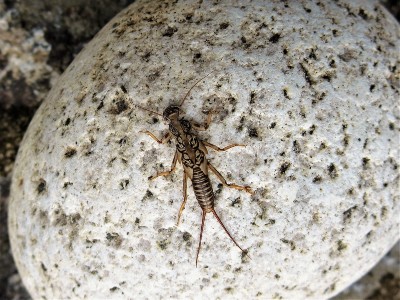But as for me, I would seek God, and to God I would commit my cause — Who does great things, and unsearchable, marvelous things without number. Job 5:8-9
Sometime during the autumn months, I wrote about how nutrients from tree leaves which fall into mountain streams can be recycled into the food chain (see The Recyclers). Pictured above is a shed casing, or exoskeleton, of a stonefly. These critters play a big part of the food chain in those streams.
It always does my heart good to see stonefly casing along the rocks and logs near the rivers. One reason is that stoneflies cannot tolerate polluted water. Stoneflies are what scientists call indicator species. Seeing evidence of these aquatic insects indicates that the water quality is either good or excellent as far as lack of water pollution is concerned. These critters also need a high oxygen concentration in the water, an additional indicator of a healthy mountain stream.
Another reason I like to see evidence of stoneflies is because they are a preferred food of trout. And a trout on the end of my fly line can make for a very special day on the river. I’ve managed to take a few photos of stonefly-eating fish before releasing them, and posted them on this blog ( Cutthroat Trout Trout Logic Kokanee Salmon Spawning)
Depending on the source, I’ve read that there are about 500 species of stoneflies in the USA and anywhere from 1,500 to 3,500 species on the planet. That’s a lot of nutrient recycling, and a lot of fish food!
Some species of stoneflies produce eggs will hatch in just a few weeks while others take several months. After hatching, the early life stage of the stonefly is called a nymph. At this phase of life, the stonefly eats primarily leaves, algae, and dead plants. As these insects grow, they shed their hard exoskeleton and form a new, larger one. This process is called molting, and may happen between 10-30 times or more.
When the final molt is about to occur, the nymph climbs out of the water onto a rock or log, and then the adult stonefly emerges. If you look closely at the above photo, you can see where the top of the casing is split open to allow the adult to emerge and leave its hard exoskeleton behind. The casing itself is now just a hollow, empty shell which once protected a live stonefly.
The adult stonefly looks similar to its final exoskeleton, except now it has large wings folding over its back. As adults, stoneflies live only a few days or weeks. Once the males and females mate, the female deposits her eggs in the stream. Then the life cycle begins once again.
As complex as this life cycle is for a single stonefly, the above Scripture reminds us that God has done so many wondrous things like this that they are too many to number.
What an awesome Creator. Want to know how to have your own relationship with Him? See Got God
Hope you have a great day.


 Moose III – Moose Snoot
Moose III – Moose Snoot
Leave a Reply